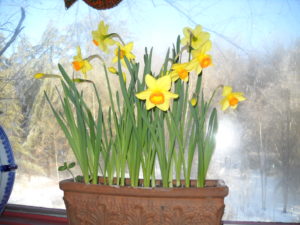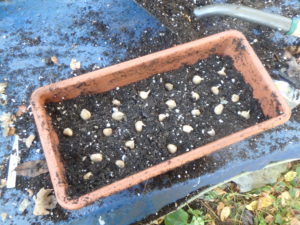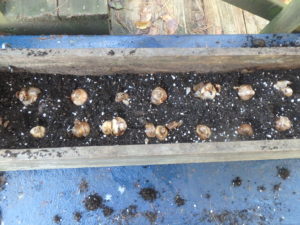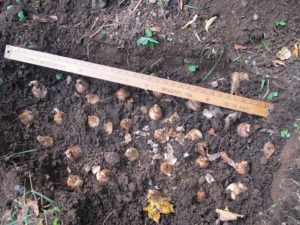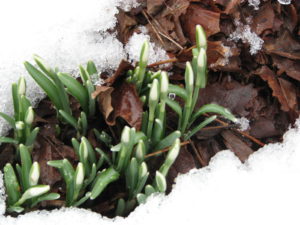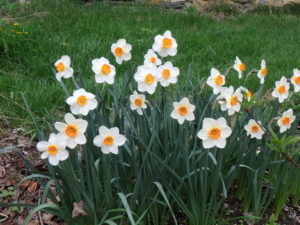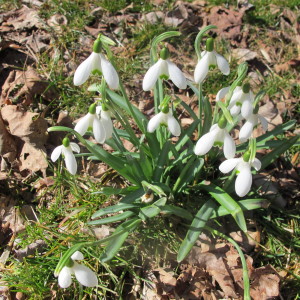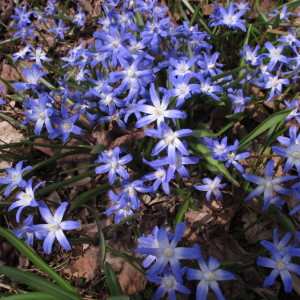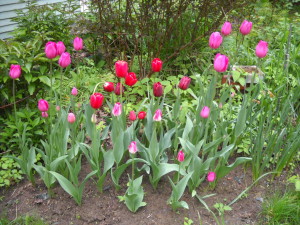Tips for Forcing Spring Bulbs Indoors
One of the easiest, and most satisfying, gardening activities I do each year is to plant tulips, daffodils, hyacinths and crocus in containers each fall. I keep them in a place that is cold, but not freezing, for 3 or 4 months, then bring them into the warmth of the house where I get gorgeous blossoms when snow may still be on the ground. I recently potted up a dozen containers with spring-blooming bulbs.
There are a few things you should know about forcing bulbs. First, you will need a cold dark place where you can store your bulbs after planting them in containers. Thirty-five to fifty degrees Fahrenheit is best, though if the temps go down below freezing for a while, that’s all right, too.
Second, it is important to select bulbs that are labeled “early” or “mid-season”, not “late-season”. It is important label each pot with the date you planted it so you can decide when to bring it into the warmth of the house. If you bring in tulips too early you will get leaves, but not blossoms. Always wait 4 months for tulips to be ready.
Daffodils only need to rest for 3 months before you bring them into the house. The smaller bulbs will do fine with even less. You will see the noses of snowdrops or crocus pop up out of the planting mix, begging for some sunshine so they can bloom.
Planting bulbs for forcing is easier than planting them outdoors. All you need are a few appropriate containers and some potting mix. I use my window box each year, forcing 25 daffodils in a box roughly 36 inches long, 7 inches deep and 7 inches from front to back. It has holes drilled in the bottom for drainage, which is important – no bulb likes soggy, poorly drained soil.
When preparing any container for planting, fill it about half way up with a good potting soil. Or you can mix the potting soil with compost to make a 50-50 mix. Or you can make your own potting mix using peat moss, compost and perlite or vermiculite.
Perlite is the white stuff you often see in commercial potting mixes – it looks like Styrofoam. But it is actually an expanded mineral that has been heated until the moisture inside it makes it pop like popcorn. It is great for keeping soil mixes lightweight and holds air, which is important for roots. Vermiculite is another expanded mineral – this one from mica. It is lightweight, but holds water.
The soil mix you use should never be allowed to dry out completely when forcing bulbs. This means you need to check on the pots once a month. If the soil mix is dry, you need to water lightly. I like to start with a mix that is quite moist when I plant the bulbs. If you use bagged peat moss in making a mix, be sure to moisten it a few days in advance. Peat moss does not quickly absorb water when it is fully dry.
So you have your pot half full of potting mix. How many bulbs can you fit into the pots? I often use rectangular clay pots that are a foot long and 5 inches deep and from front to back. If using small bulbs like crocus, I plant 20 or 25. For larger bulbs like daffodils or tulips I plant 10 or 12 in the same size pot. In a round 8-inch pot I planted 3 hyacinths this year. I plant bulbs closer in a pot than I would outdoors.
Once planted, cover the bulbs with your potting mix and pat the soil with your hands to firm it up around the bulbs. Then give the pots a light watering and place in a cool place, as described above.
If you don’t have a cold basement, you might place them in a garage or even on the steps coming up outdoors from your basement. Just remember that they must develop roots and start growing in a cold, not freezing location.
Depending where you store your bulbs, mice or squirrels will eat tulips and other bulbs indoors just as greedily indoors as out. And I’ve even had them dig daffodils out of pots and leave them in disgust –they must wonder who would want to eat them.
The easiest solution to the rodent problem is to cover each container with a piece of plywood cut to the size of the container. Just be sure to check the containers often, come spring. I’ve had bulbs start growing, hit the plywood and get all bent over.
To maximize the number of blooms you get, you can plant two layers of bulbs. Plant crocus or other small bulbs over daffodils or tulips. Just cover the bigger bulbs with soil mix, then add the small bulbs and cover them. It can be quite dramatic. I have done this outside, too.
By mid-winter I am aching to see blossoms. Since I won’t be seeing them outside, I love to have them inside. If you have had trouble with animals eating your tulips, forcing bulbs indoors is a good way to enjoy them – without fear of squirrels digging them up or deer eating the flowers. Plant them now, or certainly by mid-December, and enjoy them in early spring.
Henry can be reached at henry.homeyer@comcast.net. He is the author of 4 gardening books.
When – and How – To Plant Bulbs for Spring Blossoms
When the soil drops to 60 degrees Fahrenheit at proper planting depth, you can plant bulbs. You’ll need a soil thermometer, but that’s a handy device anyway – they’re useful in the spring to see if the soil is warm enough to plant tomatoes or eggplants without making them recoil in shock like a sixth grader wading into a chilly pond.
Soil thermometers are similar to the probes sold for testing turkey temperatures in the oven. A steel probe with a dial on top. You just poke it into the soil and wait a moment. Sometimes I put a pieces of tape at different locations: 3 inches for crocus, 6 inches for daffodils, 8 inches for tulips. Then I can easily see the temperature without digging. They are available at garden centers, or on-line.
Why sixty degrees? In soil warmer than that, your bulbs may sprout, thinking it’s spring. That’s not lethal, but not desirable. You do want the soil warm enough so that the bulbs will establish roots now, getting them ready for action in spring and holding them in place against frost heaves.
I tested the soil in a few places recently to see if it’s ready to plant. In full sun in my vegetable garden, the soil was slightly above 60 degrees, but in a shady flower bed the soil was in the high fifties. And down 8 inches it was 4 or 5 degrees cooler. I’ll plant crocus later, as the soil at crocus depth (3 inches) is warmer than deep down.
I bought my house 47 years ago, and I’ve been planting bulbs most years ever since. Most places suitable for bulbs, have bulbs. So this year I shall plant some in the lawn. Not daffodils, as the foliage can’t be cut back until July, and that would keep the lawn looking unkempt. But I could plant small bulbs like crocus, snowdrops or scilla. Their foliage dies back early enough that I’ll be able to mow the lawn when needed without compromising the bulbs. I’ll plant them by poking holes in the lawn with my CobraHead weeder (www.CobraHead.com).
Some years ago I was visiting a garden in Wales. The gardener had a bucket of tennis balls, and was tossing them onto the lawn. “What in the world are you doing,” I asked. He explained that he wanted to plant bulbs in a random pattern. Wherever a ball landed, he planted a bulb. Maybe I’ll try that.
I like to consider tulips as annuals. They do come back in year two at about 50 percent of year one, and year 3 is usually about 50 percent of that. So in general I buy 100 tulips, plant them all in the vegetable garden, and enjoy a big burst of color. I cut most and use in the house, or as gifts. I plant right over them after blooming, not worrying at all if they survive. A few will pop up in the lettuce the following year.
Daffodils are not attractive to rodents or deer as bulbs or as flowers. In fact, they are vaguely poisonous. But tulips are tasty to critters. Last year I planted a few cloves of garlic in with my tulips to repel rodents. I don’t generally have trouble with deer – I have a ferocious corgi who scares them off. They think she is a wolf, I suppose.
If you have deer problems, you probably will want to plant tulips in big swaths and then surround them with a temporary fence before they bloom. Even a 4-foot chicken wire fence should deter them, I think. There are repellents, of course, but I’ve never used any with tulips.
I have 3 books in my personal library about bulbs. All say to plant tulips and daffies 6 inches apart. I don’t. It uses too much space. I plant them three inches apart, and they do fine.
There are two keys to success when planting most spring-blooming bulbs: First, plant in full sun. Yes, in principle, you can plant daffodils in the woods if there are no evergreens and they will get enough energy from the sun before the maples leaf out. But they will do better in a sunny border. Root competition from trees diminishes their vigor.
Second, plant bulbs in soil with good drainage. Soggy soil is a death knell to most bulbs. If you have a heavy clay soil that holds water, plant your bulbs on a slope. Toss away half the soil you dig out and mix a light, fluffy compost with the other half. Dig deeper than needed, and fill with that same fluffy mix.
I don’t regret a penny I’ve spent on bulbs. Yes, some can be expensive. Yes, some don’t perform well. But by the end of a long New England winter I am so ready for blossoms I am willing to do almost anything (short of a deal with the devil) to get flowers blooming outdoors.
So go buy bulbs now. Later, when it’s time to plant, the best ones will be sold out. Start at your local garden center and look on-line for a few fancy things. Do this every year, and you’ll be delighted!
Is it okay to prune shrubs now? Learn which ones can be pruned by reading Henry’s blog post at https://dailyuv.com/news/
Planting Bulbs
For the past 3 decades or more I‘ve planted the bulbs of spring-blooming plants every fall. Some years it was just a couple of dozen, other years more than 100. October is a good time to plant them, though one year I was traveling and didn’t plant my bulbs until November. I had to shovel snow off the ground to plant bulbs that year.
I plant bulbs because it gives me something to look forward to during the depths of winter. I dream of clouds of purple scilla and white snowdrops, hillsides awash with golden daffodils, vases of tulips on every flat surface of the house. For the price of dinner for two at a moderate restaurant, you can buy 100 bulbs or more – and now is the time to do so.
I love snow drops (Galanthus nivalis). Granted, they’re small and their blossoms hang down so they’re hard to see their faces well, but they’re the first to bloom, often coming up through frozen soil in early March. I transplanted fifty or a hundred from my childhood home in Connecticut 35 years ago, and by now I have uncountable numbers. They sneak into my lawn, popping up far from where I put them. I don’t know how they move around – perhaps by seed, or perhaps with the help of those otherwise pesky rodents, the squirrels.
Other early bloomers are scilla (Scilla siberica) and glory-of-the-snow (Chionodaxa spp.), both blue to purple (glory-of-the snow also comes in pink and white). Like snowdrops, they’re small – so they need to be planted in groups of 50 or more to really look good.
Crocuses also can bloom early, though I’ve never had any as early as my snowdrops. There are at least 80 species of crocus and many hundreds of colors, but most garden centers and grocery stores just offer a couple of species and three colors – large purple, white or yellow. For that reason I study the bulb catalogs to explore other possibilities.
The bulb company McClure and Zimmerman has an excellent array of crocus, but I find their website awkward, so it is probably worth calling for a print catalog (800-546-4053). Brent and Becky’s bulbs is a family run business that is also excellent (www.brentandbeckysbulbs.com or 804-693-3966). You may be surprised to see that crocus bulbs can cost over a dollar each, but the rarer varieties are pricey.
Daffodils are wonderful, in part, because animals don’t eat them, not rodents, not deer. There are hundreds of kinds of daffodils in 13 major categories. Some bloom early, some late. Some produce one flower per stem, others several. I continue to explore the daffodils each year by buying some new ones- and you should, too.
If you grow hostas, you know that their leaves don’t get very big until June or July. I like to plant clumps of daffodils between clumps of hosta so that their leaves will cover the foliage of the daffodils after they bloom.
In recent years I have been buying 100 tulips and planting them in one bed. I like them as cut flowers – and they make terrific gifts. I like having enough to pick dozens at a time, and having them all come into bloom at once.
Most tulips, for me, tend to run out of energy and get fewer in number as the years pass, so now I consider them annuals. I dig a hole about 4-5 feet long and 2 feet across and plant all 100 in one place. Then, once they are done, I cut off the foliage and plant annual cut flowers like zinnias for summer enjoyment. Wasteful? I suppose, but life is short, and I love them so.
I’ve found that my CobraHead weeder (www.CobraHead.com or 866-962-6272) works well for planting individual small bulbs like snowdrops or crocus in the lawn. I just push it into the soil the appropriate depth, pull back to create a small slice in the soil, take out the tool and drop in a bulb. The slice in the lawn closes up easily with a push of my hand.
My last bits of advice on planting bulbs: add some slow-release organic fertilizer (or bulb booster) at planting time, and mix plenty of compost into the soil. Bulbs need good drainage to thrive, and compost helps with that. If you are worried about rodents, you can sprinkle them with cayenne pepper, though its effect only lasts for a year.
Lastly, buy plenty of bulbs. Come spring, you’ll revel in their beauty and enjoy them much more than that ephemeral dinner for two you might skip now in order to afford their cost.
Read Henry’s blog about how to save your dahlia tubers for next year at https://dailyuv.com/news/
Planting Bulbs
This is one of my favorite times of the year. Trees are turning brilliant colors, food from the garden is in the larder, and it’s bulb planting time. Some bulbs have a bad reputation: tulip bulbs for example, are often food for squirrels, and their blossoms are often munched by deer. But I know that if I plant daffodils, I’ll get blossoms six or seven months later and nothing will even think about eating them. Daffies are sure winners.
Daffodils will thrive and survive in sun or part shade. I grew up in Connecticut in a house that had a nice wooded back yard and a path through it that was lined with hundreds of daffodils. Maybe thousands. They multiplied and survived and bloomed year after year.
The soil was a dark woodland soil nourished by decomposing leaves. There was good drainage – which is important, as bulbs can rot if planted in heavy, wet soil. Occasionally my parents would dig up some big clumps and divide them, but really, we did almost nothing and the daffodils thrived.
I called Brent and Becky’s Bulbs, a family-owned business in Virginia to talk about my experience with daffodils. Their catalog says daffodils need half a day of sunshine even after the leaves come on. Why, I asked owner Becky Heath, did those daffodils of my youth do so well in our woods?
Becky said that daffodils do best in nutrient-rich soil. Our soil was that. She also said that some types do better than others. There are more than a dozen categories of daffodils, and of these, the Cyclamineus group includes many of the most shade-tolerant varieties. These are not the classic daffodil: their petals lean backward, away from their trumpet – sort of like the ears of a dog with his head out the window of a fast moving car.
Becky also told me that daffodils in the Cyclamineus group also do better than other types of daffodils in wet, heavy clay soils. ‘Tweety Bird’, ‘Jack Snipe’ and ‘February Gold’ are examples in this group.
If you read a package of daffodil bulbs carefully, you will probably see that each variety is labeled Early, Mid-Season or Late. In the past I have always selected some from each time period. But Becky Heath suggested to me that I focus primarily on bulbs that bloom early because much of my property is getting quite shady – especially where I want to plant bulbs – and early bloomers do better in part shade than late bloomers. Examples of early spring daffodils include ‘Rijnveld’s Early Sensation”, and many of the miniature varieties.
Bulbs expend a huge amount of energy in order to produce flowers. Those bulbs need to be “re-charged” each year or they will decline and have less energy for blooming next year. They do this through the miracle of photosynthesis – sunshine on their leaves produces food for the bulbs. Leaves on early-blooming bulbs generally come up and get to work early in the spring – before trees have leaves. If a bulb can get the needed energy before the leaves appear, it will thrive. Many daffies still have green leaves through June.
That theory is supported by this: my snowdrops and Scilla and Glory-of-the-Snow have thrived and multiplied, even in shade. They are small flowers that come up in March, long before the maples have leafed out. They have done much better than the daffodils planted near them.
According to Becky Heath, another factor in the success or failure of bulbs is whether or not they are hybrids. Hybrids don’t self-pollinate and re-seed themselves. Those that are called “species” daffodils do spread and naturalize by seed, she said. Thus some of the older varieties do better than the “new, improved” hybrids.
Some gardeners plant bulbs one-by-one with a little tool that can dig a round hole when plunged into the soil. I find that hard work, and slow. I prefer to dig one big hole that will hold 25 bulbs or more. I dig the hole, add some organic fertilizer and scratch in some compost. I want daffodils to have about 6 inches of soil covering the bulbs, or less for the small bulbs.
After a long winter, I long for color. You may think of daffodils as just one color – yellow – but some varieties can offer white, orange, pinkish peach, and lots of variations of colors I can’t name. But whatever you choose, plant some bulbs now for a punch of color in the spring.
Henry’s e-mail address is henry.homeyer@comcast.net, or you may reach him at P.O. Box 364, Cornish Flat, NH 03746. If you have a question, please include a self-addressed stamped envelope.



